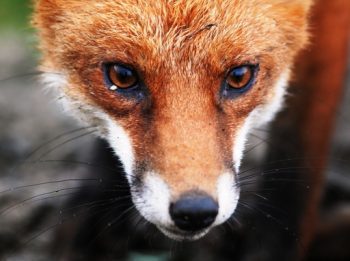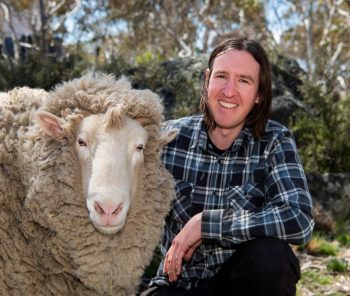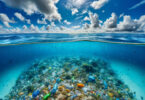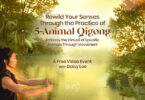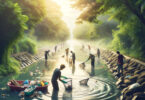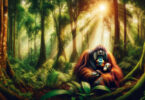December 20th, 2018
Guest writer for Wake Up World
Australia is a beautiful and unique place. Cut off from the rest of the world and only colonised in the last few centuries, the animals and environment have been largely untouched for thousands of years. Many species and plants are unique only to Australia, and inside of this relatively small country are even smaller areas where rare species and plants call home.
I am lucky to live in one of these small areas where some species of animals and plants are so rare they’re endangered, native only to this Alpine region, found nowhere else in the world.
With the arrival of the British “First Fleet” in 1788 also came the arrival of introduced animals, people refer to today as “feral.” These introduced animals are having an impact on the delicate ecosystems and “native animals” that have been mostly unchanged or challenged for thousands of years.
But what is a native animal and what is a feral animal? We are struggling to find common ground on this basic question. If you think of the animals living in Australia before the First Fleet and colonisation, do you classify them as all being native? What about the Dingo, a dog like species that was introduced by Indigenous Australians from China, thousands of years ago? Do you classify the Dingo as native as it was here before the First Fleet or is it introduced as it was humans whom brought it here?
It’s a tough question and it brings up another interesting topic – “how long a time frame till an animal becomes native?” If you want to talk about the Earth as a whole, everything is native. The plants, animals and humans are all native to Earths giant ecosystem. If you look more closely over a longer period of time, one thing you realise nature and ecosystems do well is change. Change is a huge part of the natural world, we can witness it with our own eyes through the changing of seasons. Everything has adapted to this changing of seasons quite well, which brings up the argument that specific prey species have not had the time to adapt to introduced predators, or specific plants have not built up a form of defence or protection from different grazing animals.
There is an argument that a predatory animal becomes native once the prey species has adapted to survive to it being there. This is a very controversial topic as a lot of conservation effort is focused on keeping things exactly how they are or were. If prey animals adapt to introduced predators and the predator becomes native, have we failed on some basic level at conserving the ecosystem? You could almost argue that conservation in its most basic definition doesn’t align with natural law, that ecosystems are built to change and by trying to create a system where things don’t change is like paddling up river without a paddle.
Of course, I personally agree that we have messed up big time on many levels. As it was our misdoing, surely, we have to put some good effort into cleaning up our mess? But how much is too much or not enough and how do we know we’re doing the right thing?
If you break it right down, the simple fact is the ecosystem can completely look after and fix itself. It’s wholly self-sustaining and needs no “fixing” from us. Hell, we are here today by some miracle after 5 mass extinction events, one of them wiping out over 80% of all life!! How did that happen without humanity directing things and intervening?
The next obvious question then becomes “who made us the boss?” Do we think, based on our intelligence we need to reign supreme over a wild and untameable nature that we only superficially know, yet barely understand? This question is much deeper than it would seem as you take a dive into our very human psychology; our fear of death, dying, the unknown and our fear of change. Change is exactly a form of death in some regards. Death is also inevitable, just like change. We all know this subconsciously, but accepting it directly is something many of us have gotten quite good at pushing away or “forgetting.” This denying or forceful forgetting causes our fear to manifest in other ways. If you just look at our society’s declining mental health, you would have to agree there are things we’re not willing to face. Don’t take this out of context, I’m not saying all our issues are directly related to these fears, but I do use this as an EXAMPLE.
When you look at the ecosystem, specifically with introduced species, are we projecting our own suppressed fears of death and change onto the very animals and environment we want to protect? What would happen if we accepted introduced animals as being here stay and then tried to manage things that way? Would this free us, so we could finally use our intelligence and actually work to make a real difference? Is our own fear of change what makes us cling to wanting to conserve everything as it is right now, so we don’t have to go through the anxiety and fear of change itself? It is a big question and it has implications throughout our whole culture, much outside the scope of this topic today.
You may notice, as much as I have, the extreme hatred some people have towards introduced animals. People state to love animals, but the hatred they have towards introduced animals is bizarre and honestly a little frightening. Like these introduced “others” are not animals at all, but some oppressive alien life form with a single objective to simply destroy and wreak havoc. There are a myriad of other excuses or reasons trying to justify this hatred as being the good guy, but Ghandi said it best “The enemy is fear. We think it is hate; but it is fear.” This suggests the barebones hatred people express for introduced animals is simply reflecting their own personal fear of change and loss. Or is it more like a cognitive disconnection? Because following Earths natural law and the fact that everything is connected, this hatred has no real place and makes no logical sense. So, the only other obvious conclusion is it’s a choice to remove oneself from the problem, and try to look at it from an “outside” perspective. The problem with that is we aren’t outside at all, we are and always have been just as connected with nature as all the animal are. Humans are a huge part of nature, like it or not, you can’t remove yourself from the problem.
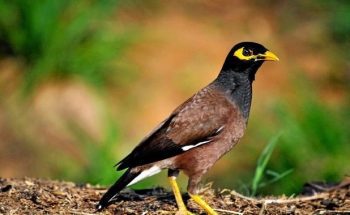
The Indian Myna Bird, an introduced species, is considered a pest in Australia and is subject to local eradication programs.
You could argue that the human impact of introducing animals is speeding up change and destruction, similar to the theory of climate change. The climate is always changing however, just as the ecosystems do, but thanks to us humans we are forcing it to change way too fast hurtling us and everything else toward catastrophe! By our introduction of animals, are they causing extinction to loom closer and closer for the native species?
In a way yes, but overall research says no. An article from The Conversation website agrees “habitat destruction is the gang leader that joins forces with other threats to accelerate the slide to extinction.” In other words, introduced animals are a symptom for extinction events, but the real culprit is humanity. What it does clearly state is that loss of habitat due to human expansion is the number one cause for animals becoming endangered and/or extinct.
In 2016 Nature published a paper by Sean Maxwell a Conservational Scientist from Queensland University. Sean and his co-authors studied a total of 8688 species. Of those, 6241 are threatened by human “overexploitation.” We are killing too many of them or harvesting too many of the things they need to survive. This also includes things like logging, which affects 4049 species then hunting and fishing which affects 2790 species.
Agricultural activity is next, affecting a total of 5407 species out of those original 8688. It’s not just the space we’ve taken up, it’s the chemicals used to control pests and the lack of habitat for insects that other species rely on to survive. Basically, if we’re not growing food where their food used to be, we’re knocking down the houses of wildlife to build our own. Just like the local sheep farmer who killed over 400 protected Wedge Tail Eagles as they were killing his lambs, yet he owns a huge property where there is no wildlife left. Rabbits are seen as a massive problem in some areas of Australia, but by removing them and clearing the rest of the land for farming, what do we expect the eagles to eat?
Urban development comes in at third with a total of 3018 species affected. Invasive species, which include feral animals and plant life are included in the study, however, are dwarfed by human overexploitation, agriculture and urban expansion.
In-fact, pollution and invasive species come in around the same, yet no-one is throwing their hands up in the air about all the pollution the Alpine ski resorts and tourism in my area emit each year. I enjoy skiing as much as many people in my community do. It’s an amazing pastime and gets people outside, appreciating the beauty that sits right at our front doorstep. But I also don’t pretend this activity doesn’t have an impact. Blaming animals that can’t come up with a clever rebuttal just so I can pretend I’m no longer part of the problem and no longer have to worry about it.
We’re all part of the problem in some way and it gets worse. Between 1970 and 2012 according to the WWF (World Wildlife Fund) the population of non-human vertebrate animals on Earth dropped by 58 percent. The human population in that time doubled! Basically speaking, as we lose an animal we gain a human. The planet can only support a finite amount of life and the biggest killers to wildlife are the stuff that keeps us humans alive and the stuff that makes our lives easy and worth living.
This is basic science, yet we are happy to avoid this hard-hitting truth as it means we are all guilty. If you look deeper into our culture, it reveals we don’t like being wrong or even owning up to our mistakes. It’s so much easier to pass the blame so you don’t have to deal with it and in this case, the blame comes down to the animals that can’t deny their wrongdoing. We can easily corral animals into doorways that fit our expansive human world, but if you try to fit too many things into a box, eventually the side will blow out.
So where does this leave us? Researching new management methods and implementing them is expensive. Even if we want to ignore the science. Trap Neuter Return programs have been proven to be HIGHLY successful, so why aren’t they even researched here in Australia? You can guess why, like many things in our world today it boils down to priorities around money. The leaders we vote in would be much happier spending taxpayer dollars on mega mines that will exasperate everything, because they will get a big return (they hope) for doing so. Voters will be happy our economy is strong so they will keep voting them in. Protecting the environment yields very little, if any return. In fact, it generally COSTS money. It’s not a good economic investment. But it is an investment in our very lives. Culling is also really cheap and on the surface it seems to fix the problem… For the short term anyway.
Wildlife ecologist Dr Billie Lazenby has been researching that culling feral cats does more damage than good. Lazenby thinks the unexpected observation may be explained by the fact that dominant cats are often bolder and more confident and so more likely to explore traps than subordinate cats. “If you remove a dominant individual from an open population you’re likely to get a few subordinates coming in to check out the territory that’s been freed up,” she says. So once the “trappable” dominant cats had been removed, this allowed an influx of many more subordinate animals, she says. “That’s why we observe this spike in cat numbers following our culling operation,” says Lazenby. This is called the vacuum effect and has been well researched in other places around the world.
So, we are right back to the beginning again all the while mindlessly killing animals that don’t deserve it and actually making things worse! Especially when you consider some of the methods of “controlled culling” like the use of 1080 poison. Banned everywhere in the world except Australia and New Zealand for it’s indiscriminate and horribly cruel killing methods, 1080 has been shown to get into waterways, poison and kill fish and kill anything that eats it. This includes secondary ingestion, so many airborne predators and scavengers (like our protected Wedge Tail Eagle) die from eating a dead contaminated animal.
“What we really should be focusing on when we talk about managing introduced species like feral cats is reducing their impact.” Lazenby says that using fences to exclude cats or increasing the number of hiding places (such as log piles) for small prey may be more effective strategies to protect biodiversity.
The above example is illustrating hope where we can actually use our intelligence to make a difference, rather than let our egos continue to destroy the world. It’s not all bad, we’re in a very prosperous position to witness the actions or lack of action now and imagine what the future will hold, something animals don’t do. A perfect example of this is an experiment into training Northern Territory Quolls not to eat the poisonous introduced cane toad. By giving them small harmless pieces of a cane toad laced with a small amount of medicine that makes them feel pretty ill, but doesn’t harm them, we are actually “training” them to survive. So far, the experiment has been very successful.
There is no way to deny that this is a very hard topic to talk about. How can you remain compassionate to ALL species, introduced, feral and even humans, while trying to protect, as best we can the endangered native wildlife? I don’t pretend to have all the answers and no matter where you look things seems to be getting worse. What I do hold value in is my own child like innocence of knowing right from wrong. Is it right to kill one group to save another? That is warfare mentality and Hitler had that very same idea mind you… I’m sure if you asked a child this question, they would always say NO. Killing for no real reason when there are clearly better options, that actually work, is never right no matter the reasons or the ways you try to justify it.
I truly hope we are able to put our prejudices aside, let go of our want to reign supreme over nature and instead work side by side with it in harmony, because we have to change something. By 2020 (basically tomorrow) the WWF estimates that the percentage of non-human vertebrates killed or extinct will be 70 percent. That means the current loss rate for non-human wild vertebrates is 12 percent every 8 years, which means we have about 20 years left before every wild animal on Earth is gone. In the space of 70 years, humans could manage to wipe out every part of wild animal life on Earth. You have to ask yourself, is that the sort of planet you want to live on?
About the author:
Raised in his family’s various Wildlife Parks in Australia, George has always been passionate about the environment and animals. He works as an Animal Communicator at www.wildvoices.com.au with the intention to improve and repair the relationship between Humans and Animals.
George can be contacted directly at [email protected].

If you've ever found value in our articles, we'd greatly appreciate your support by purchasing Mindful Meditation Techniques for Kids - A Practical Guide for Adults to Empower Kids with the Gift of Inner Peace and Resilience for Life.
In the spirit of mindfulness, we encourage you to choose the paperback version. Delve into its pages away from screen glare and notifications, allowing yourself to fully immerse in the transformative practices within. The physical book enriches the learning process and serves as a tangible commitment to mindfulness, easily shared among family and friends.
Over the past few years, Wake Up World has faced significant online censorship, impacting our financial ability to stay online. Instead of soliciting donations, we're exploring win-win solutions with our readers to remain financially viable. Moving into book publishing, we hope to secure ongoing funds to continue our mission. With over 8,500 articles published in the past 13 years, we are committed to keeping our content free and accessible to everyone, without resorting to a paywall.

